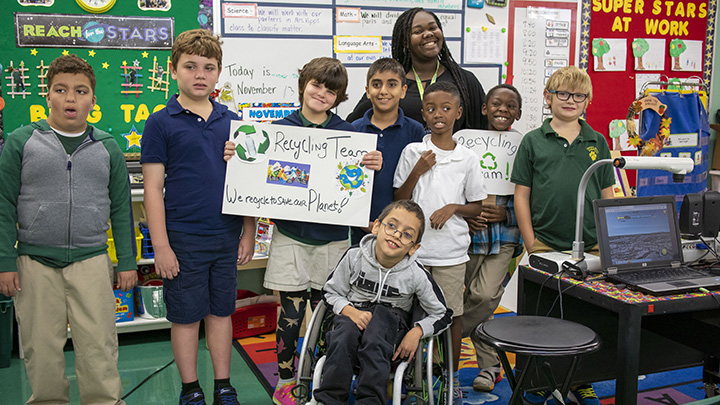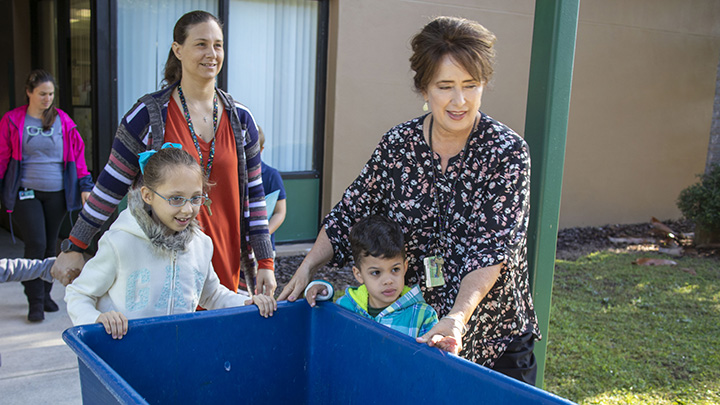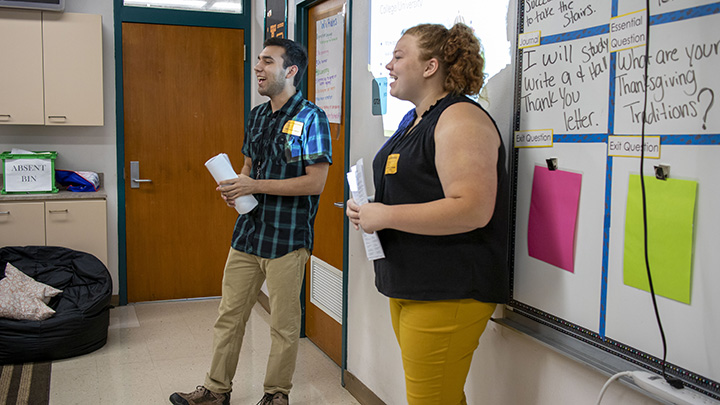2020 News Stories
ESE majors use service-learning projects to gain experience in local schools

USF student Kylah Dawson with students at Hunter's Green Elementary. USF students coordinated various service learning projects at local schools to get better acquainted with the classroom environment they will immerse themselves in during future coursework.
by Jessenia Rivera
It’s a Wednesday morning. As students assemble in their seats, backpacks are roughly unzipped. The clatter of pencils and the bang of notebooks on desks are heard from a mile away. Most have taken to chat with friends, yet some are slumped in their chairs with hopes of catching a few more minutes of sleep.
Though this may seem like an ordinary day for students at Hunter’s Green Elementary School, it most definitely isn’t for Level 1 interns in the Exceptional Student Education (ESE) program at USF.
Dr. Elizabeth Doone, instructor and university liaison for Hunter’s Green, says the practicum course, one of the first experiences USF education majors have in the classroom as part of their degree program, is designed to ease future teachers into a school environment by having them spend a full day each week at their assigned schools. The experience gives students a first-hand glimpse into what the day-to-day life of an educator is like.
“The whole goal of this first experience is to provide them with the opportunity to see the culture of a school,” Dr. Doone said. “In addition, we want them to understand the roles and responsibilities of a teacher.”
In the Fall semester, students in the course were assigned to observe at two different schools: Hunter’s Green Elementary and Plant City High School. Upon arrival at an ESE classroom in one of the two schools, students are told to analyze the school’s climate and the classroom environment.
After much observation and interaction with students in the school, USF students form groups and are then tasked with identifying a need or issue they feel should be addressed to benefit the school community. These groups then strategically create a service learning project that their ESE classrooms can participate in, and implement it on their school’s campus.
Educating Students on the Importance of Recycling
For ESE majors Christina Shudra and Kylah Dawson, bringing awareness towards the importance of recycling proved to be a need at Hunter’s Green. Even though recycling baskets were present in her self-contained classroom, Shudra had noticed that nothing was being recycled.
“The recycling bins were being used for just regular trash,” Shudra said. “So, we saw that and said, ‘Why don’t we change that?’”
Shudra reached out to administration and custodians and discovered that there is a recycling system that visits Hunter’s Green Elementary School every Thursday. However, after speaking with other individuals in the school, she realized not many people knew about it.
Once approved to pursue the project, Shudra and Dawson planned activities for students that involved going around the school campus and getting their students to actively pick up recyclable items.
Dawson admits that she wasn’t sure how her students would react to the idea of recycling, but when she saw the enthusiasm in their faces, she knew her and Shudra had brought forth the right topic.
“I think they fell in love with the idea of recycling,” Dawson said. “It gave them something to be proud of.”

Students at Hunter's Green Elementary are assisted by their teachers as they push a large bin around the school to collect recyclables from each classroom. The service project was enacted by USF pre-service teachers who completed their practicum course at the school.
Despite the success both Shudra and Dawson had in getting their students engaged, they did have to overcome a few hurdles. While Shudra struggled with gaining confidence, Dawson felt her biggest challenge was managing behavior—skills they have the opportunity to refine throughout their studies at USF.
“I was kind of having a hard time figuring out how I should deescalate situations,” Dawson said. “But my mentor teacher gave me a lot of good tips. I saw how she did it and from that I have an idea of how I would do it when I become a teacher.”
When talking about how they grew in their roles as pre-service instructors, Shudra recalls how their project put them in the position to reach out to administrators, faculty and non-educational staff. In doing so, she was able to understand how having great communication skills is necessary as an educator.
“I think (the project) helped me realize that communication is important,” Shudra said. “Even if someone doesn’t have the answer, you have to find someone else that does.”
Supporting Teacher Well-Being
Stationed in a different classroom at Hunter’s Green, was another group who looked towards their instructors when determining a need for their Service Learning Project.
Sioban Henderson and her group had noticed how burdened their three varying exceptionalities (VE) teachers were throughout the day, and decided to create customized care packages for them.
“With the scheduling and the constant moving they were never really in one place,” Henderson said. “My group and I wanted to do something special for the teachers because they were visibly stressed.”
After getting permission from other educators, Henderson and her group sought donations by creating flyers they had students take home with them. The flyers contained a list that included self-care items and supplies such as paper, markers, hand sanitizers and small whiteboards.
Though Henderson and her group aimed to provide the classroom’s teachers with supplies to better serve their students, they also wanted them to feel appreciated for all the work they do. Their project emphasized the idea that helping teachers is what ultimately helps students.
“They have to teach kids, but they also need to take care of themselves so they can take care of their kids,” Henderson said.
Providing Relevant Life Skills to Students with Disabilities
While their classmates were implementing their projects at Hunter’s Green, another group of students observing at Plant City High School focused on providing meaningful life skills for an older age group.
When speaking with the students in her classroom, ESE major Rebecca Davey realized that most of them had little to no knowledge about their career and financial options after high school.
“The 18 to 22-year-olds class didn’t really have any experience with finding or applying for jobs,” Davey said. “So, we expanded in the small part of their curriculum they do focus on and gave them more resources, because we felt like it wasn’t being covered enough.”
Throughout the four weeks of implementing their project, Davey and her group provided their class with informational presentations and materials that helped them explore the career paths they can take. Students were taught how to build their resumes and fill out job applications, while also being guided on how the interviewing process plays out.
“We explained what reasonable accommodations are and what rights they have as a person with a disability in the workplace,” Davey said. “We also played an example video that went over the do’s and don'ts of interviewing.”
As she interacted with students and guided lessons throughout the semester, Davey says she was able to understand to some degree what makes students tick and what doesn’t. While it was difficult at times to keep the class connected to the serious topic she and her group presented, she said her time at Plant City High School has given her confidence in her abilities to teach.
“I think my experience solidified that I want to (teach at a) high school,” Davey said.

To help older students better prepare for life after high school, USF students Harry Bradley and Calista Legeyt-Damm teach a life skills lesson at Plant City High School.
Similar to the preparatory lessons presented by Davey and her group, fellow classmates Calista Legeyt-Damm and Cameryn Anthony also noticed a need in another classroom down the hall. The group found the class they worked with didn’t have much motivation to excel in their studies and they had little knowledge about the decisions they’ll soon make as working adults.
“A lot of the students were kind of just floating around in high school. They didn’t see any kind of future for themselves,” Legeyt-Damm said.
When coordinating a plan, Legeyt-Damm and Anthony became aware of a Learning Strategies course being offered to ESE students at the high school that allowed for them to complete missing assignments or make-up work.
When analyzing the environment of this specific class, they realized that students weren’t being too productive. Both girls spoke with their university instructor, Dr. Sarah Semon, and were then guided on how they could use the class time wisely.
Legeyt-Damm and Anthony decided to give students a pre-assessment survey that asked students about topics such as their employment status, whether or not they had a bank account, and what their plans were after high school.
The answers they saw written on the surveys gave the group clear indication that a financial literacy class needed to be implemented, and they got to work immediately.
“We teamed up with Junior Achievement of Tampa Bay and they donated supplies we could use to create a curriculum for the learning strategies class,” Anthony said. “Based on those resources, we did a five-week financial literacy skills class.”
Legeyt-Damm and Anthony, along with other individuals in their groups, covered subjects concerning money management, budgeting, checking/savings accounts, debit and credit cards, credit scores and what debt looks like at the national level.
Once students realized how useful the information is for the next chapter of their lives, Anthony says they began to respond positively to their lessons. As the semester came to a close, Legeyt-Damm and Anthony were approached by one student in particular who had already started to apply what she learned.
“The best part of it was when one of the students stated that she used the list of banks we gave her and opened a bank account with her mom’s permission,” Anthony said. “The bank account helped her start to manage her money better.”
Though both were nervous about teaching children that are a few years younger than them, their time in a co-teach classroom at Plant City allowed them to see the practices that work best.
All in all, both girls can say the experience has left them better prepared to enter the teaching field.
“It has made me very patient,” Legeyt-Damm said. “Getting that first taste really opened my eyes to a lot.”
The Exceptional Student Education program prepares teachers to work with children who have emotional and behavioral disorders, intellectual disabilities, and specific learning disabilities. To learn more, visit the program’s website.